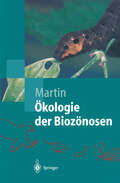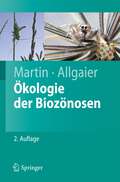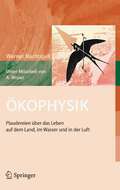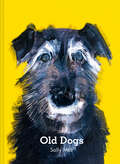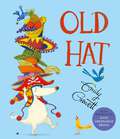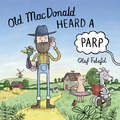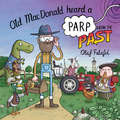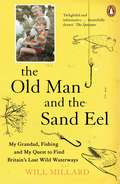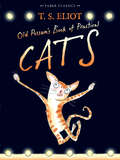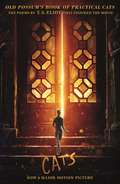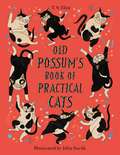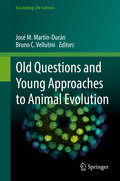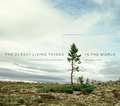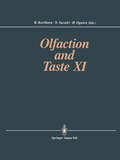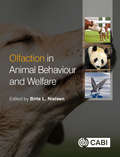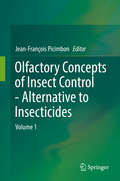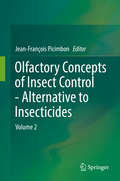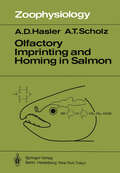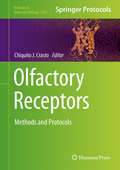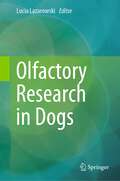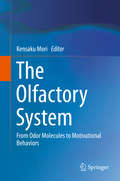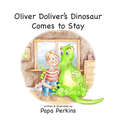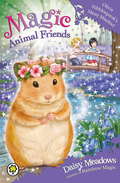- Table View
- List View
Ökologie der Biozönosen (Springer-Lehrbuch)
by Konrad BachDas Buch behandelt die Wechselbeziehungen der Arten in ökologischen Gemeinschaften und deren Bedeutung für die Struktur und Organisation von Ökosystemen. Unter Berücksichtigung aktueller Forschungsergebnisse stellt der Autor Formen und Wirkungen der Interaktionen einzeln sowie integriert im komplexen Gefüge der Biozönosen dar. Dabei geht es um die zentrale Frage: Welches sind die Prozesse, die das Vorkommen der Arten bestimmen? Fallbeispiele sowie rund 140 Abbildungen vermitteln das Wissen anschaulich – auch für Einsteiger in die Ökologie geeignet.
Ökologie der Biozönosen (Springer-Lehrbuch)
by Konrad Martin Christoph AllgaierPhytophagie, Prädation, Konkurrenz und Mutualismus bestimmen die vielfältigen Wechselbeziehungen zwischen Pflanzen, Tieren und Mikroorganismen in ihren jeweiligen Lebensräumen. In dieser ersten deutschsprachigen Einführung zur Ökologie der Biozönosen betrachten die Autoren die Wirkungen dieser Interaktionen: auf die Zahl der Arten und Individuen und auf die Regulationsprozesse in Biozönosen. Grundlagen und jüngste Forschungsergebnisse werden anhand zahlreicher Fallbeispiele und detailgenauer Zeichnungen und Grafiken anschaulich vermittelt.
Ökophysik: Plaudereien über das Leben auf dem Land, im Wasser und in der Luft
by Werner NachtigallProf. em. Dr. rer. nat. Werner Nachtigall, geb. 1934, war als Zoophysiologe und Biophysiker Leiter des Zoologischen Instituts der Universität des Saarlandes in Saarbrücken. In Forschung und Ausbildung hat er sich insbesondere mit Aspekten der Technischen Biologie und Bionik befasst und mit seinen Forschergruppen viele Basisdaten insbesondere zur Ökologie, Physiologie und Physik des Fliegens und Schwimmens aber auch zur Stabilität beispielsweise der Gräser erarbeitet. Lebewesen überraschen immer wieder durch ihre "Biodiversität", ihre hochspezifischen Ausgestaltungen und Anpassungen. Dabei nützen sie auch alle physikalischen Grundgesetzlichkeiten. Das zentrale Thema ist die Ortsbewegung, die ja auf dem Boden und in den Fluiden (Wasser, Luft) denkbar unterschiedlich abläuft. Ergänzende Themenkreise sind Körpergröße und Stoffwechsel, Atmung und Atemgastransport, Wärme- und Wasserhaushalt. Mit dem vorliegenden Buch, das in Zusammenarbeit mit Dr. rer. nat. Alfred Wisser entstanden ist, stellt er solche Forschungsergebnisse in einen größeren Rahmen und berichtet kenntnisreich und allgemein verständlich über die "Ökophysik" des Lebens auf dem Land, im Wasser und in der Luft – mit Gewinn zu lesen von jedem, der sich für Biologie oder für Physik interessiert (oder gar für beides).
Old Dogs
by Sally MuirFollowing the success of A Dog a Day (Pavilion, 2017), Sally Muir returns with a collection of new, but crucially old, faces.
Old Hat
by Emily GravettA very funny, charming story all about the joy of finding your own style, full of brilliantly inventive hats for children to spot. Old Hat is a fresh, colourful and punchy book from the creator of Wolves and Dogs and twice-winner of the Kate Greenaway Medal, Emily Gravett.Harbet likes his comfy knitted hat, but the others keep jeering at him – OLD HAT! OLD HAT! No matter what headwear he buys – be it a towering fruit platter hat, an old-boot-on-the-head hat or a brightly lit traffic cone hat, Harbet cannot keep up with the latest fashions. As soon as he gets a brand new hat it is already an . . . OLD HAT! It seems that Harbet will never fit in. But when one day he decides to go his own way, Harbet discovers just how much more fun it is to stop following others and think for yourself.
Old MacDonald Heard a Parp
by Olaf Falafel“Old Macdonald heard a parp … E-I-E-I-O!” There are some VERY rude noises coming from Old Macdonald’s farm – who could be responsible?! Sing along to this side-splitting picture book adaptation of everyone’s favourite nursery rhyme.
Old MacDonald Heard a Parp from the Past
by Olaf FalafelParp through the past with giggles galore in this third fart-tastic tale from the hilarious Olaf Falafel!
The Old Man and the Sand Eel
by Will Millard'A wonderfully fluent account of how the strange magic of water and the beings that inhabit it can enchant and intoxicate' Chris YatesGrowing up on the Cambridgeshire Fens, Will Millard never felt more at home than when he was out with his granddad on the riverbank, whiling away the day catching fish. As he grew older his competitive urge to catch more and bigger fish led him away from that natural connection between him, his grandfather and the rivers of his home. That is, until the fateful day he let a record-breaking sand eel slip through his fingers and he knew that he had lost the magic of those days down by the river, and that something had to change. The Old Man and the Sand Eel is at its heart the story of three generations of men trying to figure out what it is to be a man, a father and a fisherman. It plots Will's scaly stepping stones back to his childhood innocence, when anything was possible and the wild was everywhere.***'[Will Millard] is a master wordsmith and his first book is a joyful testament to that' Isabelle Broom, Heat'[Will Millard] writes with a genuine sense of humility (...) humour and reflection' Kevin Parr, Countryfile 'Delightful and informative (...) beautifully drawn (...)The Old Man and The Sand Eel will be enjoyed by anyone who loves the challenge and mystery of baiting a hook and plopping it into the water' Spectator'This is post-modern nature writing that embraces beauty where it finds it and marvels at nature's tenacity (...) But there's more here than just fish. This is also a book about growing up, about how to retain a connection with those who raised you while forging your own identity - what to keep and what to discard. And it's about men. The strong surges of emotion that both draw them together and keep them apart, and the shared pastimes which recognise that intimacy and meaning aren't always accompanied by words' Olivia Edward, Geographical
Old Possum's Book of Practical Cats: with illustrations by Rebecca Ashdown (Faber Children's Classics Ser. #13)
by T. S. Eliot'The cat himself knows and will never confess...'To celebrate Old Possum's 75th anniversary we have commissioned lively new illustrations from Rebecca Ashdown for T.S. Eliot's original book of Practical Cats. Featuring Macavity, the Mystery Cat; Mr Mistofelees, the Original Conjuring Cat; Mungojerrie and Rumpelteazer and all the gang, this is a must for every child's bookshelf and is a great companion to the Andrew Lloyd Webber stage show.
Old Possum's Book of Practical CATS: Cats Movie Tie-in (Faber Children's Classics Ser. #13)
by T. S. EliotCats! Some are sane, some are mad and some are good and some are bad.Meet magical Mr Mistoffelees, sleepy Old Deuteronomy and curious Rum Tum Tugger. But you'll be lucky to meet Macavity because Macavity's not there!In 1925 T.S. Eliot became co-director of Faber & Faber, who remain his publishers to this day. Throughout the 1930s he composed the now famous poems about Macavity, Old Deuteronomy, Mr Mistoffelees and many other cats, under the name of 'Old Possum'. In 1981 Eliot's poems were set to music by Andrew Lloyd Webber as Cats, which went on to become the longest-running Broadway musical in history and is now a film starring Taylor Swfit, Idris Elba, Judi Dench, Ian McKellen, Rebel Wilson, Jennifer Hudson, Jason Derulo, Francesca Hayward and James Corden. With illustrations by Rebecca Bagley.
Old Possum's Book of Practical Cats (Faber Children's Classics Ser. #13)
by T. S. EliotThe naming of Cats is a difficult matter,It isn't just one of your holiday games;You may think at first I'm as mad as a hatterWhen I tell you, a cat must have THREE DIFFERENT NAMES.So begins one of the best-known poetry collections of all time. The practical cats need no introduction, but this stunning new full-colour version, illustrated by Júlia Sardà, is the perfect companion to Old Toffer's Dogs. Whether you are a cat or a dog person, you will be enchanted by Júlia's highly original interpretation.
Old Questions and Young Approaches to Animal Evolution (Fascinating Life Sciences)
by José M. Martín-Durán Bruno C. VellutiniAnimal evolution has always been at the core of Biology, but even today many fundamental questions remain open. The field of animal ‘evo-devo’ is leveraging recent technical and conceptual advances in development, paleontology, genomics and transcriptomics to propose radically different answers to traditional evolutionary controversies. This book is divided into four parts, each of which approaches animal evolution from a different perspective. The first part (chapters 2 and 3) investigates how new sources of evidence have changed conventional views of animal origins, while the second (chapters 4–8) addresses the connection between embryogenesis and evolution, and the genesis of cellular, tissue and morphological diversity. The third part (chapters 9 and 10) investigates how big data in molecular biology is transforming our understanding of the mechanisms governing morphological change in animals. In closing, the fourth part (chapters 11–13) explores new theoretical and conceptual approaches to animal evolution. ‘Old questions and young approaches to animal evolution’ offers a comprehensive and updated view of animal evolutionary biology that will serve both as a first step into this fascinating field for students and university educators, and as a review of complementary approaches for researchers.
The Oldest Living Things in the World
by Rachel SussmanThe Oldest Living Things in the World is an epic journey through time and space. Over the past decade, artist Rachel Sussman has researched, worked with biologists, and traveled the world to photograph continuously living organisms that are 2,000 years old and older. Spanning from Antarctica to Greenland, the Mojave Desert to the Australian Outback, the result is a stunning and unique visual collection of ancient organisms unlike anything that has been created in the arts or sciences before, insightfully and accessibly narrated by Sussman along the way. Her work is both timeless and timely, and spans disciplines, continents, and millennia. It is underscored by an innate environmentalism and driven by Sussman’s relentless curiosity. She begins at “year zero,” and looks back from there, photographing the past in the present. These ancient individuals live on every continent and range from Greenlandic lichens that grow only one centimeter a century, to unique desert shrubs in Africa and South America, a predatory fungus in Oregon, Caribbean brain coral, to an 80,000-year-old colony of aspen in Utah. Sussman journeyed to Antarctica to photograph 5,500-year-old moss; Australia for stromatolites, primeval organisms tied to the oxygenation of the planet and the beginnings of life on Earth; and to Tasmania to capture a 43,600-year-old self-propagating shrub that’s the last individual of its kind. Her portraits reveal the living history of our planet—and what we stand to lose in the future. These ancient survivors have weathered millennia in some of the world’s most extreme environments, yet climate change and human encroachment have put many of them in danger. Two of her subjects have already met with untimely deaths by human hands. Alongside the photographs, Sussman relays fascinating – and sometimes harrowing – tales of her global adventures tracking down her subjects and shares insights from the scientists who research them. The oldest living things in the world are a record and celebration of the past, a call to action in the present, and a barometer of our future.
The Oldest Living Things in the World
by Rachel SussmanThe Oldest Living Things in the World is an epic journey through time and space. Over the past decade, artist Rachel Sussman has researched, worked with biologists, and traveled the world to photograph continuously living organisms that are 2,000 years old and older. Spanning from Antarctica to Greenland, the Mojave Desert to the Australian Outback, the result is a stunning and unique visual collection of ancient organisms unlike anything that has been created in the arts or sciences before, insightfully and accessibly narrated by Sussman along the way. Her work is both timeless and timely, and spans disciplines, continents, and millennia. It is underscored by an innate environmentalism and driven by Sussman’s relentless curiosity. She begins at “year zero,” and looks back from there, photographing the past in the present. These ancient individuals live on every continent and range from Greenlandic lichens that grow only one centimeter a century, to unique desert shrubs in Africa and South America, a predatory fungus in Oregon, Caribbean brain coral, to an 80,000-year-old colony of aspen in Utah. Sussman journeyed to Antarctica to photograph 5,500-year-old moss; Australia for stromatolites, primeval organisms tied to the oxygenation of the planet and the beginnings of life on Earth; and to Tasmania to capture a 43,600-year-old self-propagating shrub that’s the last individual of its kind. Her portraits reveal the living history of our planet—and what we stand to lose in the future. These ancient survivors have weathered millennia in some of the world’s most extreme environments, yet climate change and human encroachment have put many of them in danger. Two of her subjects have already met with untimely deaths by human hands. Alongside the photographs, Sussman relays fascinating – and sometimes harrowing – tales of her global adventures tracking down her subjects and shares insights from the scientists who research them. The oldest living things in the world are a record and celebration of the past, a call to action in the present, and a barometer of our future.
Olfaction and Taste XI: Proceedings of the 11th International Symposium on Olfaction and Taste and of the 27th Japanese Symposium on Taste and Smell Joint Meeting held at Kosei-nenkin Kaikan, Sapporo, Japan, July 12–16, 1993
by Kenzo Kurihara Noriyo Suzuki Hisashi OgawaIn this compendium of current studies on olfaction and taste - the most comprehensive yet to appear in this series - the chemical senses are elucidated from points of view ranging from anatomy, electrophysiology, molecular biology (especially chemoreceptor gene cloning), biochemistry, and psychophysics to the latest clinical and technological applications of chemosensory research. Specific topics include the structure and function of the tastebud and olfactory epithelium; the genetics and mechanisms of olfactory and taste transduction; the chemistry and function of flavor compounds; the psychophysics of taste and olfaction in daily human life; the brain mechanisms of coding, learning, and memory in olfaction and taste; the clinical assessment of taste and olfaction with special reference to aging and disorders; noninvasive measurements of human olfactory and taste responses for therapeutic purposes; artifical sensing devices; chemoreception in aquatic organisms and other species; and chemosensory transduction in insects. With its multidisciplinary approach, this volume will be an invaluable source of information not only for researchers, clinicians, and students but also for technologists in fields such as artificial sensing, perfumery, brewery, food chemistry, aquafarming, and agriculture.
Olfaction in Animal Behaviour and Welfare
by Dr Luisa Amo Dr Raimund Apfelbach Dr J. Elizabeth Bolhuis Dr Vincent Bombail Dr Roisin Campbell-Palmer Dr Caroline Clouard Dr Laurent Dormont Dr Markus Fendt Dr Peter Hepper Dr Tadeusz Jezierski Dr Olivia Le Moëne Dr Frédéric Levy Dr Nicolas Meunier Dr Raymond Nowak Dr Marije Oostindjer Dr Olivier Rampin Dr Frank Rosell Dr Roland Salesse Dr Burton Slotnick Dr Deborah Wells Dr Tristram D. Wyatt Birte L. NielsenEvidence-based, yet entirely practical, this important new text builds upon the basics of neuroscience to describe the links between olfaction and animal behaviour, and the effects of odours in animal welfare. Animals use smells in a multitude of ways: to orientate themselves, to create social bonds, to recognise food, to initiate reproduction, and to avoid predators and imminent threats such as fire. Starting from the scientific basis of olfaction and odour perception, the book covers pheromones and behavioural tests, before describing the role of olfaction in feeding behaviour, reproduction, disease detection, and animal housing. The book: · is written in an evidence-based way, yet with an easy-to-understand style, making it accessible to non-experts · focuses on animals managed by humans, i.e. farm, zoo, lab and companion species · is illustrated by in-depth research examples of many different species This is a captivating introduction to the world of smells, suitable for advanced students, researchers, and teachers of applied ethology, animal welfare and veterinary science.
Olfactory Concepts of Insect Control - Alternative to insecticides: Volume 1
by Jean-François PicimbonEvolution gave rise to a prominent insect diversity at every level of ecological niche. Since then, hordes of insects have threatened human and cattle health as well as most of all green lands and agricultural crops. Now, the insect problem expands from many mutant forms of yellow dengue fever mosquitoes to highly-resistant larvae of most all various phytophageous species. The tremendous expansion of insects is due not only to an increasing resistance capacity to insecticides, but also to a strong capacity for adapting to different climate and environmental changes, including global warming. Obviously insects display a number of rudimentary systems to build an extremely efficient organism to survive in a changing world. In many species, one pheromone molecule is enough to trigger mating behavior. Therefore, insects have become crucial models not only for evolutionary studies, but also for understanding specific mechanisms underlying sensory-based behaviors. Most of insect species such as ants, beetles, cockroaches, locusts, moths and mosquitoes largely rely on olfactory cues to explore the environment and find con-specifics or food sources. A conglomerate of renowned international scientific experts is gathered to expose the insect problem on the various continents of the planet and propose an alternative to the use of toxic insecticides. Sex pheromones, specific chemical signals necessary for reproduction, and pheromone detection in insects are described with full details of the olfactory mechanisms in the antennae and higher centers in the brain. Thus, new synthetic pheromones and/or plant odors with specific molecular target sites in the insect olfactory system are proposed for sustainable development in agricultural and entomological industries. Disrupting insect pheromone channels and plant odor detection mechanisms is solemnly envisioned as a unique way to control invasive insect pest species while preserving human and environment safety.
Olfactory Concepts of Insect Control - Alternative to insecticides: Volume 2
by Jean-François PicimbonEvolution gave rise to a prominent insect diversity at every level of ecological niche. Since then, hordes of insects have threatened human and cattle health as well as most of all green lands and agricultural crops. Now, the insect problem expands from many mutant forms of yellow dengue fever mosquitoes to highly-resistant larvae of most all various phytophageous species. The tremendous expansion of insects is due not only to an increasing resistance capacity to insecticides, but also to a strong capacity for adapting to different climate and environmental changes, including global warming. Obviously insects display a number of rudimentary systems to build an extremely efficient organism to survive in a changing world. In many species, one pheromone molecule is enough to trigger mating behavior. Therefore, insects have become crucial models not only for evolutionary studies, but also for understanding specific mechanisms underlying sensory-based behaviors. Most of insect species such as ants, beetles, cockroaches, locusts, moths and mosquitoes largely rely on olfactory cues to explore the environment and find con-specifics or food sources. A conglomerate of renowned international scientific experts is gathered to expose the insect problem on the various continents of the planet and propose an alternative to the use of toxic insecticides. Sex pheromones, specific chemical signals necessary for reproduction, and pheromone detection in insects are described with full details of the olfactory mechanisms in the antennae and higher centers in the brain. Thus, new synthetic pheromones and/or plant odors with specific molecular target sites in the insect olfactory system are proposed for sustainable development in agricultural and entomological industries. Disrupting insect pheromone channels and plant odor detection mechanisms is solemnly envisioned as a unique way to control invasive insect pest species while preserving human and environment safety.
Olfactory Imprinting and Homing in Salmon: Investigations into the Mechanism of the Imprinting Process (Zoophysiology #14)
by A.D. Hasler A.T. ScholzChance Favors Only the Prepared Mind How does a scientist go about the task of pushing back the curtains of the unknown? Certainly the romance of tackling the mysteries of nature provides the motivation, for who would not be inspired by the remarkable life history of this romantic beast, the salmon. After living in the Pacific Ocean for several years, salmon swim thousands of kilometers back to the stream of their birth to spawn. I have always been fascinated by the homing migration of salmon. Noone who has seen a 20-kilogram salmon fling itself into the air repeatedly until it is exhausted in a vain effort to surmount a waterfall can fail to marvel at the strength of the instinct that draws the salmon upriver to the stream where it was born. But how does it find its way back? I was puzzling over this problem during a family vacation in 1946. Inspired by the work of the great German Nobel Laureates, Karl von Frisch and Konrad Lorenz, I had been conducting research with my graduate student Theodore Walker, since 1945, on the ability of fishes to discriminate odors emanating from aquatic plants. Von Frisch had studied schooling minnows and discovered that, if broken, their skin emitted a con specific chemical substance, termed Schreckstoff, which caused other members of its school to disperse and hide.
Olfactory Receptors: Methods and Protocols (Methods in Molecular Biology #1003)
by Chiquito J. CrastoDespite the best efforts of many and despite landmark discoveries and experimental ingenuity, challenges in the pursuit of research related to olfactory receptors (ORs) continue to exist. In Olfactory Receptors: Methods and Protocols, experts in the field contribute chapters that serve to address these challenges. The volume consists of several sections: knowledge dissemination of ORs, theoretical assessments of OR structure and function, as well as development and use of expression systems and experimental functional analysis. Written in the highly successful Methods in Molecular Biology™ series format, chapters include introductions to their respective topics, lists of the necessary materials and reagents, step-by-step, readily reproducible laboratory protocols, and tips on troubleshooting and avoiding known pitfalls. Concise and practical, Olfactory Receptors: Methods and Protocols seeks to aid researchers in furthering the knowledge of olfaction and moving us ever closer to the thrilling discoveries that will follow.
Olfactory Research in Dogs
by Lucia LazarowskiThis book unites cutting-edge research related to various aspects of dog olfaction. It includes rich expertise about detection dogs with application perspectives, and expands beyond.In four clearly arranged sections, readers will discover specialist contributions on:the fundamentals of olfaction, anatomy, comparative olfactory neuroscience and dysfunctionmethodological reflections on canine olfactometry and essential implications for practice, comprising dog selection for scent detection, handler bias and signal detection conceptsthe connection with dog behavior, cognition, welfare, and learning and training methodsdiverse application examples of dog olfactory capabilities, such as disease detection for diagnostics, infectious disease surveillance, forensics and ecological conservationThe unique and exciting link between science and practice makes this book a valuable read not only for researchers, but also for practicing veterinarians and professionals in the fields of canine detection, chemical sensing, working dog behavior and welfare.
The Olfactory System: From Odor Molecules to Motivational Behaviors
by Kensaku MoriThis book summarizes recent advances in understanding of the mammalian and fish olfactory system and provides perspective on the translation of external odor information into appropriate motivational and behavioral responses. Following the discovery of the odorant receptor gene family in 1991, understanding of the basic biological mechanisms of the olfactory system has advanced enormously. Despite such rapid progress, however, it remains unclear how odor information is processed at levels beyond the olfactory bulb, including the olfactory cortex, olfactory tubercle, and orbitofrontal cortex. This book thus describes the most recent developments in olfactory research, with particular focus on the basic neurobiological mechanisms of the neuronal circuit function in the olfactory system and its related higher centers. Exploring the basic functional logic of the neuronal circuits in the olfactory system in this way appears to be crucial in understanding the workings of the complex neuronal circuits of the brain, particularly those in the cerebral cortex that link sensory perception to appropriate behavioral responses. This book is written for the coming generation of scientists: undergraduates, graduate students, and postdoctoral researchers in the fields of neuroscience, neurobiology, chemical senses, food and nutritional sciences, medical science, sensory psychology, and behavioral sciences.
Oliver Doliver's Dinosaur Comes To Stay
by Papa PerkinsOliver Doliver (who is really just Oliver but he does like having both names) will be mostly Oliver in this story. Oliver is six years (and one month) old and has a friend who is a Dinosaur called Aya Buddn. This is the story of how they met! And more adventures will follow.
Olivia Nibblesqueak's Messy Mischief: Book 9 (Magic Animal Friends #9)
by Daisy MeadowsWelcome to a magical world where animals talk and play - just like you and me!Lily and Jess are needed in Friendship Forest! Wicked witch Grizelda is causing trouble again, casting spells to make all the good creatures naughty!Can the girls stop Olivia Nibblesqueak the hamster before she makes the whole forest a mess?
